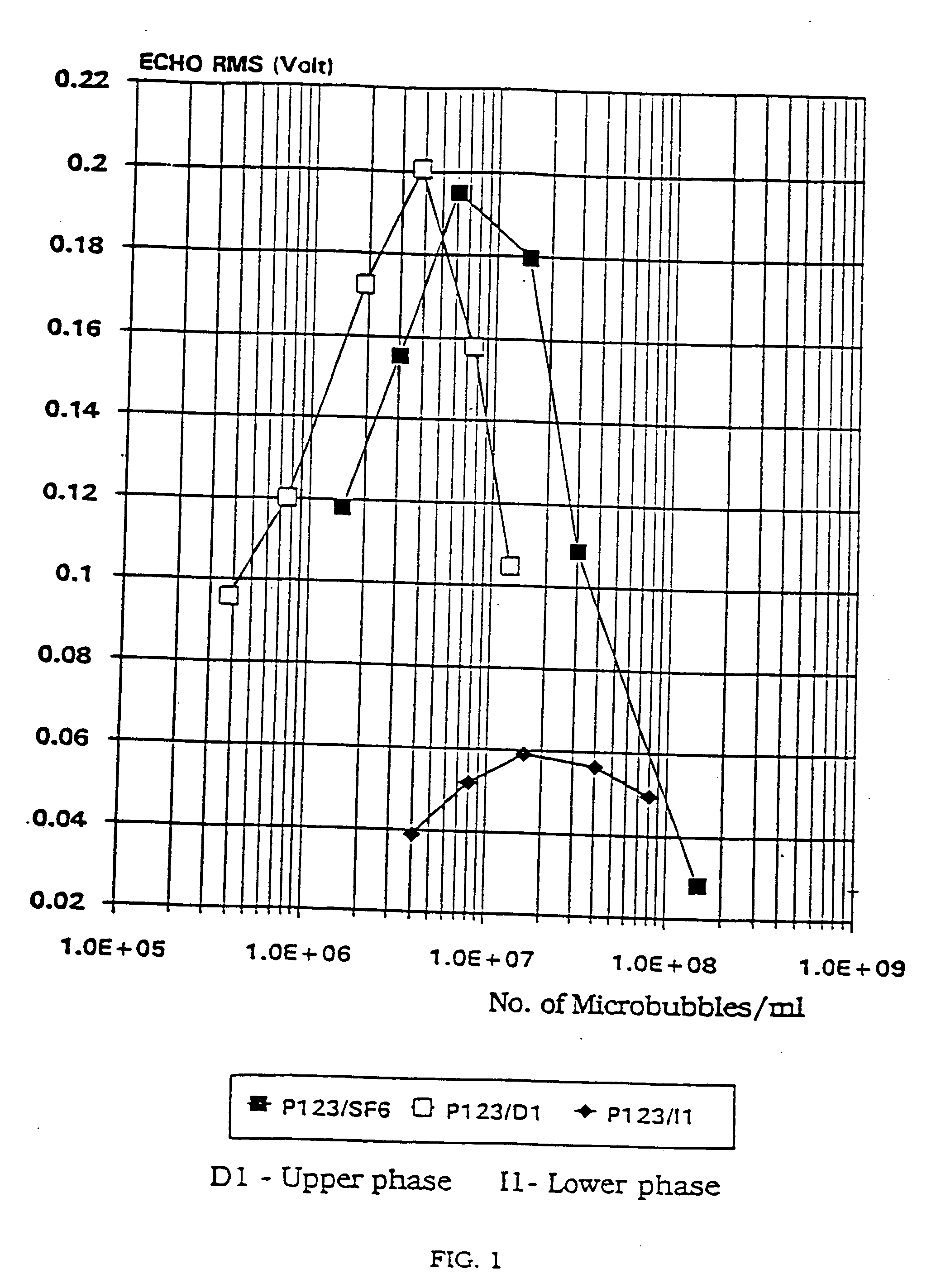Stable microbubble suspensions as enhancement agents for ultrasound echography and dry formulations thereof
a technology of ultrasound echography and suspensions, which is applied in the direction of echographic/ultrasound imaging preparations, ultrasonic/sonic/infrasonic diagnostics, transportation and packaging, etc., can solve the problems of hammering their practical use, relatively short life span of prior art compositions, and relatively low initial bubble coun
- Summary
- Abstract
- Description
- Claims
- Application Information
AI Technical Summary
Benefits of technology
Problems solved by technology
Method used
Image
Examples
example 2
[0039] Lyophilisates were prepared as described in Example 1 with air (instead of SF.sub.6) in the gas phase. The lyophilisates were then suspended in 0.9% saline (instead of a 3% glycerol solution). Similar bubble concentrations were obtained. However, after injection in the rabbit or the minipig the persistence of the effect was shorter e.g. 10-20 s instead of 120 s. Moreover, in the minipig the opacification of the left ventricle was poor even with the 10 mg / ml preparation.
example 3
[0040] MLV liposomes were prepared as described in Example 1 using 240 mg of DAPC and 10 mg of DPPA (molar ratio 95:5). Two milliliters of this preparation were added to 20 ml of a polyethyleneglycol (PEG 2,000) solution (82.5 mg / ml). After mixing for 10 min at room temperature, the resulting solution was frozen during 5 min at 45.degree. C. and lyophilised during 5 hours at 0.2 mbar. The powder obtained (1.6 g) was transferred into a glass vial equipped with a rubber stopper. The powder was exposed to SF.sub.6 (as described in Example 1) and then dissolved in 20 ml of distilled water. The suspension obtained showed a bubble concentration of 5.times.10.sup.9 bubbles per ml with a median diameter in volume of 5.5 .mu.m. This suspension was introduced into a 20 ml syringe, the syringe was closed and left in the horizontal position for 24 hours. A white layer of bubbles could be seen on the top of solution in the syringe. Most of the liquid phase (.about.16-18 ml) was evacuated while t...
example 5
[0046] The procedure of Example 4 was repeated except that the initial dissolution of the phospholipids in hexane / ethanol solution was omitted. In other words, crude phospholipids were dissolved, together with polyethylene glycol in tertiary butanol and the solution was freeze-dried; thereafter, the residue was suspended in water. Several phospholipids and combinations of phospholipids with other lipids were investigated in these experiments. In the results shown in the next table the phospholipids were dissolved in a tertiary butanol solution containing 100 mg / ml of PEG 2'000. The residues obtained after freeze drying were saturated with SF.sub.6 (see Example 1), then dissolved in distilled water at a concentration of 100 mg dry weight per ml.
2 Lipid mixture Conc. in tert- Bubble conc. Median diam. (weight ratio) butanol(mg / ml) (.times.10.sup.9 / ml) (.mu.m) DSPC 2 1.3 10 DAPC / DPPG (100 / 4) 2 3.8 7 DSPC / Chol (2 / 1) 6 0.1 40 DAPC / Plur F68 (2 / 1) 6 0.9 15 DAPC / Palm. ac. (60 / 1) 2 0.6 11 DA...
PUM
 Login to View More
Login to View More Abstract
Description
Claims
Application Information
 Login to View More
Login to View More - R&D
- Intellectual Property
- Life Sciences
- Materials
- Tech Scout
- Unparalleled Data Quality
- Higher Quality Content
- 60% Fewer Hallucinations
Browse by: Latest US Patents, China's latest patents, Technical Efficacy Thesaurus, Application Domain, Technology Topic, Popular Technical Reports.
© 2025 PatSnap. All rights reserved.Legal|Privacy policy|Modern Slavery Act Transparency Statement|Sitemap|About US| Contact US: help@patsnap.com

